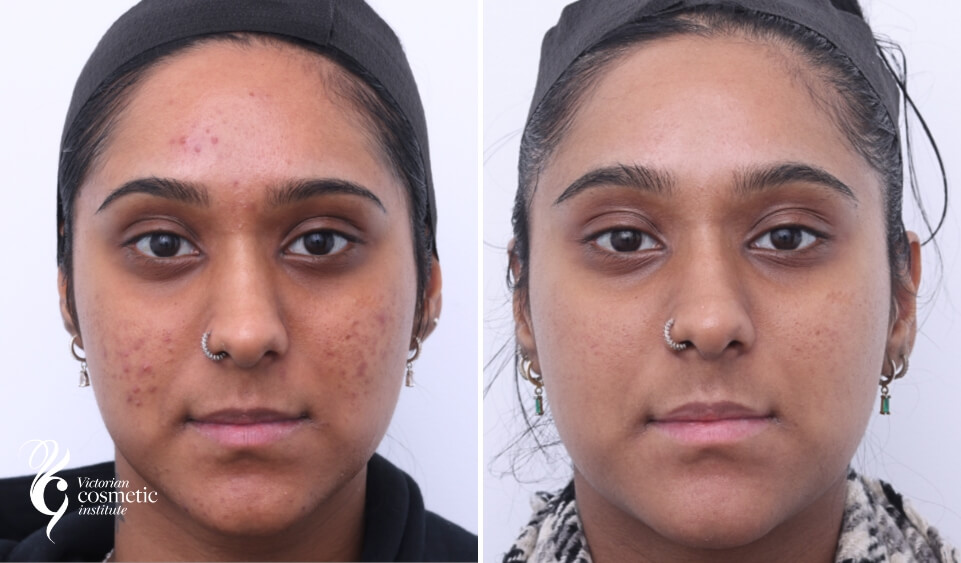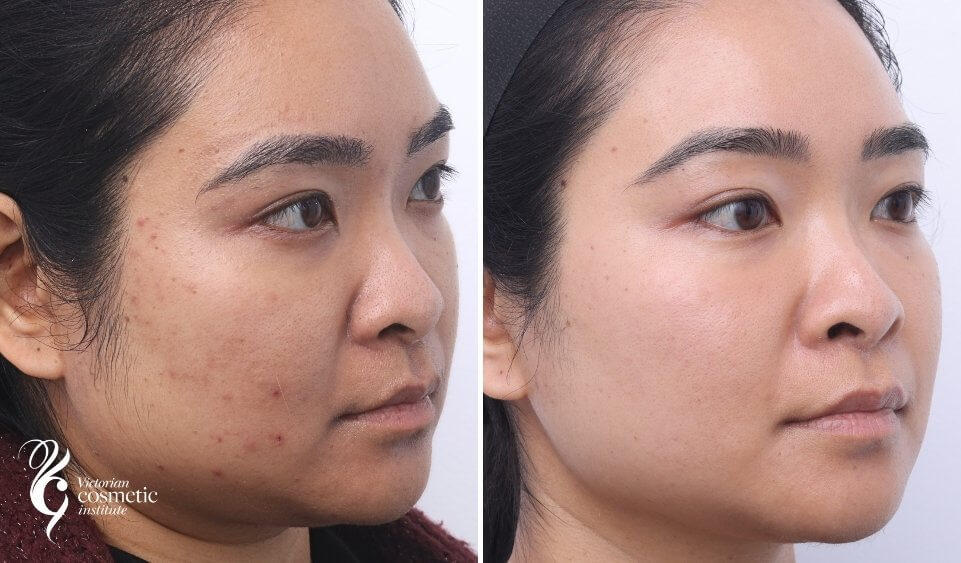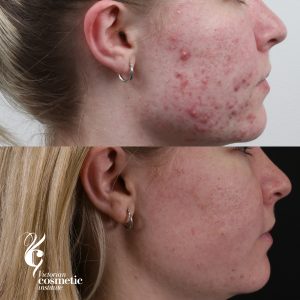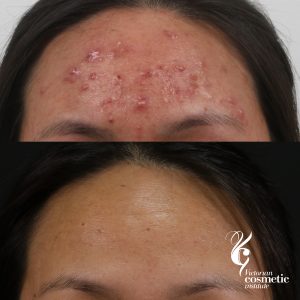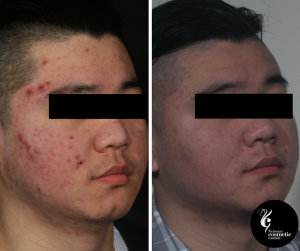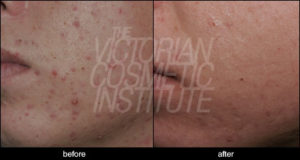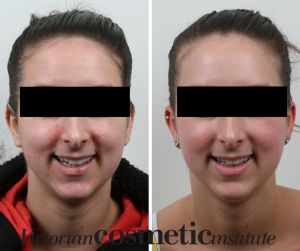Acne Treatment Melbourne
Quick Facts about acne treatment
- The causes of acne are multi-factorial and different for each person, and therefore acne treatments used vary from person to person
- Acne is a medical problem and not just a cosmetic one
- Acne left untreated can lead to permanent scarring, known as acne scarring
- The main modalities of treatment are oral medications, chemical peels, LED light therapy, and skin care for acne and congestion.
- Using appropriate sunscreen can also help with acne.
What causes acne?
There are several contributors to acne’s formation. Excess oil and sebum production exacerbated by hormonal influences on sebaceous glands, as well as dead skin physically blocking pores, can cause acne. A bacterium named Propionibacterium acnes (p.acnes) has also been implicated as a cause of acne. All treatments for acne will address one or more of these issues.
There is also a significant genetic component to acne. A twin study has shown an 81% of the factors causing acne are genetic. Also, the degree of oil or sebum production from the skin is largely inherited.
Studies have shown that regular consumption of omega-3 fatty acids and following a low-Gi or low GL diet, as well as reducing milk consumption may reduce the severity and duration of acne.
Inappropriate make-up or skincare can also be comedogenic, that is block pores and cause blackheads and breakouts. Finding appropriate skincare and make-up is a key part of treating acne.
Skin Care
A good cleanser is the first step in acne treatment. Usually, it is best to simply use a gentle cleanser and perform a double cleanse.
Exfoliants can also help. Exfoliants with beta-hydroxy acids (eg. salicylic acid) have the advantage of having anti-inflammatory properties and are more oil soluble making them penetrate oily skin better than alpha-hydroxy acids. Again, over-exfoliation of the skin can cause irritation and often exacerbation or flare-ups of acne.
Benzoyl peroxide can reduce active acne lesions and also has anti-inflammatory properties. It is available in varying concentrations. The higher the concentration, the more flaking, and irritation of the skin. Therefore, commencement should be with the lower concentrations. In our experience we have found that the skin becomes accustomed to benzoyl peroxide in the long term, and tends to have less effect the longer it is used. Also it is possible to develop a benzoyl peroxide allergy. For those reasons we generally do not recommend skincare containing benzoyl peroxide.
Topical retinoids, derivatives of Vitamin A, are also used to treat acne. They remain one of the most effective topical agents in the treatment of acne. Retinoids work by increasing the natural turnover rate of the skin. Therefore, there are fewer dead skin cells at the surface of the skin and fewer blockages. This property of retinoids also means that skin texture and fine wrinkles also improve. Some retinoids also help to reduce the number of bacteria causing acne in the skin.
Skin can usually appear red, flaky, lumpy, and irritated for up to one month after the commencement of retinoids. This is called retinoic dermatitis. Starting slowly is important to reduce these side effects. Sunscreen is also imperative with the use of retinoids as they can initially exacerbate sun sensitivity. Retinoids should not be used in pregnant mothers, those planning to be pregnant, or those who are breast-feeding.
Retinoids come in various forms. Retinoic acid, Retinol and Retinaldehyde are other forms of retinoids. Brands such as Cosmedix, Dermaceutic, Biopelle, Synergie Skin and Aspect Dr have a range of retinols of varying strength. Although more expensive than their prescription-only variants, they also contain other active ingredients to support the health of the skin and tend to be less irritating. You can learn more about retinoid products on our online skin care store.
Microdermabrasion and chemical peels
Microdermabrasion is another method of helping to physically remove dead skin cells from the surface of the skin and reduce pore blockage and acne. It is especially effective for comedones (blackheads). It also helps with the penetration of skin care products. Microdermabrasion also improves lymphatic drainage of the face.
More effective than microdermabrasion, are chemical peels. Instead of physically exfoliating the skin, chemical peels exfoliate by using substances such as alpha-hydroxy acids (fruit acids) or beta-hydroxy acids. Beta-hydroxy acid peels, also known as salicylic acid peels, are a good option for those with acne as it helps reduce inflammation associated with the acne.
Make-up / foundation
Make-up is also implicated in the cause of acne. Foundations, even those claiming to be oil-free can physically block pores and cause acne. This often leads to a vicious cycle of applying make-up to cover acne lesions, and in turn this causes more acne, leading to the use of more make-up. Acne due to make-up use is termed acne cosmetica. Mineral make-up does not block pores, and instead sits on top of the skin.
At Victorian Cosmetic Institute, we recommend mineral foundations that have have anti-oxidants and anti-inflammatory properties as well as being a mineral make-up. Importantly, mineral make up should also have an SPF factor to help prevent ageing and post-inflammatory hyperpigmentation from acne lesions.
Antibiotics
Antibiotics have also been widely used in the treatment of acne. Antibiotics work by reducing the acne-causing bacteria (including Propionobacterium acnes) at the surface of the skin. Antibiotics are most suited to inflamed acne lesions. They do unfortunately also affect the rest of the body as well as the skin, and can result in side effects such as oral and vaginal thrush, diarrhoea, liver function abnormalities, and sun sensitivity. Some antibiotics have also been associated with hyperpigmentation when used for prolonged periods.
Some antibiotics are commonly prescribed for prolonged periods. We generally do not recommend the long-term use (greater than 2 months) of antibiotics for acne as their efficacy is low and the potential side effects can be significant. Penetration into the skin can also be minimal. With widespread use of antibiotics for acne, there is increasing resistance of the acne-causing bacteria to the commonly used antibiotics, resulting in a decrease in their effectiveness.
Topical antibiotics are another option for the treatment of acne, and some of these can be purchased over-the-counter at pharmacies. As for oral antibiotics, they require a prescription from a doctor. The advantage of topical antibiotics is they have no systemic side effects, and can have some anti-inflammatory properties.
Hormonal Treatments
Particular hormones, in particular androgens, have also been known to increase oil and sebum production and exacerbate acne.
For females, options for controlling the hormones that cause acne include particular variants of the oral contraceptive pill. The variants that are of particular use are the ones containing Cyproterone acetate or Spironolactone.
Cyproterone acetate and Spironolactone work by helping to switch off the androgenic hormones, or the hormones that increase oil/sebum production and cause acne. Cyproterone acetate (Androcur) and Spironolactone (Aldactone) can also be used without the pill in those females who do not want to be on the pill. It is, however, not compatible with pregnancy, so it is not suitable for those females who are attempting to fall pregnant or who are pregnant.
Oral Isotretinoin/Roaccutane
Roaccutane, or oral isotretinoin, also a derivative of Vitamin A, is the gold standard in the treatment of acne. Prescribed only by dermatologists, it is mostly used for severe forms of acne only, as it has a number of significant side effects. Generally, a six-month course is prescribed, and involves taking a tablet or two each day. The side effects from Roaccutane are the main problem with treatment and include; dry skin, dry eyes, dry lips, cracked lips, hair loss, mood changes, and liver function abnormalities. Pregnancy must be completely excluded during treatment with Roaccutane, as it is known to cause serious birth defects.
Laser Therapy
Although there are laser treatments for acne, we generally find that they are not particularly effective, and carry unnecessary risk.
LED light therapy
LED light therapy or phototherapy is a non-invasive method of treating acne without downtime or side effects
It works on the waste product of the p.acnes bacteria, porphyrins. These porphyrins are targeted by the LED light source (usually red or blue LED) and this produces oxygen free radicals that destroy the bacteria.
Usually, multiple treatments are required.
LED light therapy is usually recommended in conjunction with other acne treatments such as chemical peels.
Acne Cyst Injections
Injection of dilute corticosteroid to quickly reduce the size and inflammation of acne cysts.
Sunscreens
Sunscreens are important to help reduce pigmentation after an acne lesion has passed. However, some sunscreens themselves can cause acne by blocking pores. At Victorian Cosmetic Institute, we recommend SkinCeuticals Ultra Facial Defense Oil Free Sunscreen. Ultra Facial Defense is an oil-free, non-comedogenic sunscreen suitable for people with oily or acne prone skin.
What do I do about the scars or marks that remain after a pimple has gone?
One of the most serious complications of acne is the scars or marks that remain. There are several treatments available to reduce the appearance of acne scarring. For more information about acne scarring click here.
Why should I choose The Victorian Cosmetic Institute as my provider of acne treatments?
Our team are educated in skin treatments and will be able to give you advice on the most appropriate treatment for you. Many acne treatments (both topical and oral) are prescription only and can only be prescribed by doctors, our collaborative environment of Skin Therapists, Nurses and Doctors allow for holistic care and service for each of our patients. We have an array of light-based therapies and chemical peels available for treating acne. The first step is to contact us for your initial consultation, where we will discuss with you what is a realistic and achievable outcome, and what to expect from your treatment. You can book your consultation online or contact us on 1300 863 824 to arrange a consultation.
Last updated April 2025.
